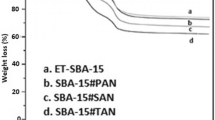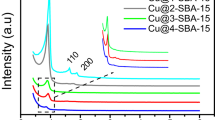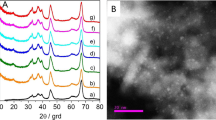Abstract
We gave an effective protocol to support Ru NPs on amine-functionalized SBA-15 mesoporous silica to catalyze the CO2 hydrogenation reaction. The amine groups present in the catalytic system performed an essential role in stabilizing the Ru NPs, delivering the robust metal-support interaction and improved catalytic activities to material in formic acid synthesis. We also demonstrated a comprehensive study of different amine groups on the catalytic performance of ultrafine uniformly dispersed Ru NPs over mesoporous SBA-15 support. The effect of various compositional and steric properties of amine groups on the size/distribution of the Ru NPs were closely studied and correlated with their catalytic performance in the CO2 hydrogenation reaction. The in situ DRIFTS analysis of CO2 hydrogenation into formic acid in presence of developed CATALYST-1 showed active surface species bonded to support sites and to Ru NPs. This interaction proposed the formation of important intermediates such as hydrides, formates and bicarbonates, which are significant for the formation of formic acid. We successfully recycled the catalysts up to 5 runs with good catalytic activity.
Graphic Abstract
















Similar content being viewed by others
References
Styring P, Quadrelli EA, Armstrong K (2014) Carbon dioxide utilisation: closing the carbon cycle: First Edition. Elsevier Inc.
Leung DYC, Caramanna G, Maroto-Valer MM (2014) An overview of current status of carbon dioxide capture and storage technologies. Renew Sustain Energy Rev 39:426–443
Aresta M (1999) Perspectives in the use of carbon dioxide. Quim Nova 22:269–272
F. Arajo O de Q, de Medeiros JL, Maria R (2014) CO2 utilization: a process systems engineering vision. In: CO2 sequestration and valorization. InTech
Liu Q, Wu L, Jackstell R, Beller M (2015) Using carbon dioxide as a building block in organic synthesis. Nat Commun 6:1–15
Artz J, Müller TE, Thenert K et al (2018) Sustainable conversion of carbon dioxide: an integrated review of catalysis and life cycle assessment. Chem Rev 118:434–504
Sakakura T, Choi JC, Yasuda H (2007) Transformation of carbon dioxide. Chem Rev 107:2365–2387
Hietala J, Vuori A, Johnsson P et al (2016) Formic Acid. Ullmann’s Encyclopedia of Industrial Chemistry. Wiley-VCH Verlag GmbH and Co. KGaA, Weinheim, Germany, pp 1–22
Mellmann D, Sponholz P, Junge H, Beller M (2016) Formic acid as a hydrogen storage material-development of homogeneous catalysts for selective hydrogen release. Chem Soc Rev 45:3954–3988
Singh AK, Singh S, Kumar A (2016) Hydrogen energy future with formic acid: a renewable chemical hydrogen storage system. Catal Sci Technol 6:12–40
Centi G, Quadrelli EA, Perathoner S (2013) Catalysis for CO2 conversion: a key technology for rapid introduction of renewable energy in the value chain of chemical industries. Energy Environ Sci 6:1711–1731
Pérez-Fortes M, Schöneberger JC, Boulamanti A et al (2016) Formic acid synthesis using CO2 as raw material: techno-economic and environmental evaluation and market potential. Int J Hydrogen Energy 41:16444–16462. https://doi.org/10.1016/j.ijhydene.2016.05.199
Jo DY, Ham HC, Lee KY (2020) Facet-dependent electrocatalysis in the HCOOH synthesis from CO2 reduction on Cu catalyst: a density functional theory study. Appl Surf Sci. https://doi.org/10.1016/j.apsusc.2020.146857
Zhang Y, Zhang T, Das S (2020) Catalytic transformation of CO2 into C1 chemicals using hydrosilanes as a reducing agent. Green Chem 22:1800–1820
Leitner W (1995) Carbon dioxide as a raw material: the synthesis of formic acid and its derivatives from CO2. Angew Chemie Int Ed English 34:2207–2221
Reymond H, Corral-Pérez JJ, Urakawa A, Rudolf Von Rohr P (2018) Towards a continuous formic acid synthesis: a two-step carbon dioxide hydrogenation in flow. React Chem Eng 3:912–919. https://doi.org/10.1039/c8re00142a
Jessop PG, Ikariya T, Noyori R (1995) Homogeneous hydrogenation of carbon dioxide. Chem Rev 95:259–272. https://doi.org/10.1021/cr00034a001
Wang W-H, Feng X, Bao M (2018) Transformation of carbon dioxide to formic acid and methanol. Springer Singapore, Singapore
Wang W-H, Hime Y (2012) Recent advances in transition metal-catalysed homogeneous hydrogenation of carbon dioxide in aqueous media. In: Hydrogenation. InTech
Jessop PG, Ikariya T, Noyori R (1994) Homogeneous catalytic hydrogenation of supercritical carbon dioxide. Nature 368:231–233. https://doi.org/10.1038/368231a0
Wang W-H, Feng X, Bao M (2018) Transformation of CO2 to formic acid or formate with homogeneous catalysts. Springer, Singapore, pp 7–42
Jessop PG, Joó F, Tai CC (2004) Recent advances in the homogeneous hydrogenation of carbon dioxide. Coord Chem Rev 248:2425–2442
Ross JRH (2012) Heterogeneous catalysis – chemistry in two dimensions. In: Heterogeneous catalysis. Elsevier, pp 1–15
Gunasekar GH, Park K, Jung KD, Yoon S (2016) Recent developments in the catalytic hydrogenation of CO2 to formic acid/formate using heterogeneous catalysts. Inorg Chem Front 3:882–895
Bulushev DA, Ross JRH (2018) Heterogeneous catalysts for hydrogenation of CO2 and bicarbonates to formic acid and formates. Catal Rev Sci Eng 60:566–593. https://doi.org/10.1080/01614940.2018.1476806
Upadhyay PR, Srivastava V (2017) Ionic liquid mediated in situ synthesis of Ru nanoparticles for CO2 hydrogenation reaction. Catal Lett 147:1051–1060. https://doi.org/10.1007/s10562-017-1995-7
Gautam P, Upadhyay PR, Srivastava V (2019) Selective hydrogenation of CO2 to formic acid over alumina-supported Ru nanoparticles with multifunctional ionic liquid. Catal Lett 149:1464–1475. https://doi.org/10.1007/s10562-019-02773-z
Liu Q, Yang X, Li L et al (2017) Direct catalytic hydrogenation of CO2 to formate over a Schiff-base-mediated gold nanocatalyst. Nat Commun 8:1–8. https://doi.org/10.1038/s41467-017-01673-3
Masuda S, Mori K, Kuwahara Y et al (2020) Additive-free aqueous phase synthesis of formic acid by direct CO2 hydrogenation over a PdAg catalyst on a hydrophilic N-doped polymer-silica composite support with high CO2 affinity. ACS Appl Energy Mater 3:5847–5855. https://doi.org/10.1021/acsaem.0c00771
Wang W, Wang S, Ma X, Gong J (2011) Recent advances in catalytic hydrogenation of carbon dioxide. Chem Soc Rev 40:3703–3727. https://doi.org/10.1039/c1cs15008a
Xi J, Wang Q, Duan X et al (2020) Continuous flow reduction of organic dyes over Pd-Fe alloy based fibrous catalyst in a fixed-bed system. Chem Eng Sci 231:116303. https://doi.org/10.1016/j.ces.2020.116303
Martín-Jimeno FJ, Suárez-García F, Paredes JI et al (2021) Nickel nanoparticle/carbon catalysts derived from a novel aqueous-synthesized metal-organic framework for nitroarene reduction. J Alloys Compd 853:157348. https://doi.org/10.1016/j.jallcom.2020.157348
Liu J, Hao J, Hu C et al (2018) Palladium nanoparticles anchored on amine-functionalized silica nanotubes as a highly effective catalyst. J Phys Chem C 122:2696–2703. https://doi.org/10.1021/acs.jpcc.7b10237
Srivastava V (2016) Active heterogeneous Ru nanocatalysts for CO2 hydrogenation reaction. Catal Lett 146:2630–2640. https://doi.org/10.1007/s10562-016-1882-7
Srivastava V (2014) Ru-exchanged MMT clay with functionalized ionic liquid for selective hydrogenation of CO2 to formic acid. Catal Lett 144:2221–2226. https://doi.org/10.1007/s10562-014-1392-4
Fan J, Gao Y (2006) Nanoparticle-supported catalysts and catalytic reactions–a mini-review. J Exp Nanosci 1:457–475. https://doi.org/10.1080/17458080601067708
Kokunešoski M, Gulicovski J, Matović B et al (2010) Synthesis and surface characterization of ordered mesoporous silica SBA-15. Mater Chem Phys 124:1248–1252. https://doi.org/10.1016/j.matchemphys.2010.08.066
Allen AD, Senoff CV (1967) Preparation and infrared spectra of some ammine complexes of ruthenium(II) and ruthenium(III). Can J Chem 45:1337–1341. https://doi.org/10.1139/v67-220
Zhao D, Feng J, Huo Q et al (1998) Triblock copolymer syntheses of mesoporous silica with periodic 50 to 300 angstrom pores. Science 80(279):548–552. https://doi.org/10.1126/science.279.5350.548
Gu D, Schüth F (2014) Synthesis of non-siliceous mesoporous oxides. Chem Soc Rev 43:313–344
Hsu YC, Hsu YT, Hsu HY, Yang CM (2007) Facile synthesis of mesoporous silica SBA-15 with additional intra-particle porosities. Chem Mater 19:1120–1126. https://doi.org/10.1021/cm062167i
Anantharaj S, Jayachandran M, Kundu S (2016) Unprotected and interconnected Ru0 nano-chain networks: advantages of unprotected surfaces in catalysis and electrocatalysis. Chem Sci 7:3188–3205. https://doi.org/10.1039/c5sc04714e
Qadir K, Kim SM, Seo H et al (2013) Deactivation of Ru catalysts under catalytic CO oxidation by formation of bulk Ru oxide probed with ambient pressure XPS. J Phys Chem C 117:13108–13113. https://doi.org/10.1021/jp402688a
Carbonio EA, Prieto MJ, De SA, Landers R (2014) From 1D to 3D Ru nanostructures on a pt stepped surface as model systems in electrocatalysis: UHV-STM and XPS study. J Phys Chem C 118:28679–28688. https://doi.org/10.1021/jp509574s
Qadir K, Joo SH, Mun BS et al (2012) Intrinsic relation between catalytic activity of CO oxidation on Ru nanoparticles and Ru oxides uncovered with ambient pressure XPS. Nano Lett 12:5761–5768. https://doi.org/10.1021/nl303072d
Durndell LJ, Zou G, Shangguan W et al (2019) Structure-reactivity relations in ruthenium catalysed furfural hydrogenation. ChemCatChem 11:3927–3932. https://doi.org/10.1002/cctc.201900481
Lin B, Guo Y, Liu R et al (2018) Preparation of a highly efficient carbon-supported ruthenium catalyst by carbon monoxide treatment. Ind Eng Chem Res 57:2819–2828. https://doi.org/10.1021/acs.iecr.7b05077
Bus E, Miller JT, Van Bokhoven JA (2005) Hydrogen chemisorption on Al2O3-supported gold catalysts. J Phys Chem B 109:14581–14587. https://doi.org/10.1021/jp051660z
Koh K, Jeon M, Yoon CW, Asefa T (2017) Formic acid dehydrogenation over Pd NPs supported on amine-functionalized SBA-15 catalysts: structure-activity relationships. J Mater Chem A 5:16150–16161. https://doi.org/10.1039/c7ta02040f
Hiyoshi N, Yogo K, Yashima T (2005) Adsorption of carbon dioxide on aminosilane-modified mesoporous silica. J Japan Pet Inst 48:29–36. https://doi.org/10.1627/jpi.48.29
Pandey PH, Pawar HS (2020) Cu dispersed TiO2 catalyst for direct hydrogenation of carbon dioxide into formic acid. J CO2 Util 41:101267. https://doi.org/10.1016/j.jcou.2020.101267
Gautam P, Srivastava V (2020) Active γ –alumina -supported Ru nanoparticles for CO2 hydrogenation reaction. Lett Org Chem 17:603–612. https://doi.org/10.2174/1570178617666191107112429
Danon A, Stair PC, Weitz E (2011) FTIR study of CO2 adsorption on amine-grafted SBA-15: elucidation of adsorbed species. J Phys Chem C 115:11540–11549. https://doi.org/10.1021/jp200914v
Liu MH, Chen HA, Chen CS et al (2019) Tiny Ni particles dispersed in platelet SBA-15 materials induce high efficiency for CO2 methanation. Nanoscale 11:20741–20753. https://doi.org/10.1039/c9nr06135e
Upadhyay PR, Srivastava V (2016) Heterogeneous silica tethered ruthenium catalysts for carbon sequestration reaction. Catal Lett 146:1478–1486. https://doi.org/10.1007/s10562-016-1772-z
Raskó J, Solymosi F (1994) Infrared spectroscopic study of the photoinduced activation of CO2 on TiO2 and Rh/TiO2 catalysts. J Phys Chem 98:7147–7152. https://doi.org/10.1021/j100080a009
Liu M, Zhang Q, Shi Y et al (2020) AuPd bimetal immobilized on amine-functionalized SBA-15 for hydrogen generation from formic acid: the effect of the ratio of toluene to DMF. Can J Chem Eng 98:879–891. https://doi.org/10.1002/cjce.23678
Farajzadeh M, Alamgholiloo H, Nasibipour F et al (2020) Anchoring Pd-nanoparticles on dithiocarbamate-functionalized SBA-15 for hydrogen generation from formic acid. Sci Rep 10:18188. https://doi.org/10.1038/s41598-020-75369-y
Mielby J, Kunov-Kruse AJ, Kegnæs S (2017) Decomposition of formic acid over silica encapsulated and amine functionalised gold nanoparticles. J Catal 345:149–156. https://doi.org/10.1016/j.jcat.2016.11.020
Luo Y, Yang Q, Nie W et al (2020) Anchoring IrPdAu nanoparticles on NH2-SBA-15 for fast hydrogen production from formic acid at room temperature. ACS Appl Mater Interfaces 12:8082–8090. https://doi.org/10.1021/acsami.9b16981
Bhattacharyya K, Danon A, Vijayan BK et al (2013) Role of the surface lewis acid and base sites in the adsorption of CO2 on titania nanotubes and platinized titania nanotubes: an in situ FT-IR study. J Phys Chem C 117:12661–12678. https://doi.org/10.1021/jp402979m
Nie W, Luo Y, Yang Q et al (2020) An amine-functionalized mesoporous silica-supported pdir catalyst: boosting room-temperature hydrogen generation from formic acid. Inorg Chem Front 7:709–717. https://doi.org/10.1039/c9qi01375j
Author information
Authors and Affiliations
Corresponding author
Ethics declarations
Conflict of interest
The authors declare no conflict of interest, financial or otherwise.
Additional information
Publisher's Note
Springer Nature remains neutral with regard to jurisdictional claims in published maps and institutional affiliations.
Rights and permissions
About this article
Cite this article
Srivastava, V. CO2 Hydrogenation over Ru-NPs Supported Amine-Functionalized SBA-15 Catalyst: Structure–Reactivity Relationship Study. Catal Lett 151, 3704–3720 (2021). https://doi.org/10.1007/s10562-021-03609-5
Received:
Accepted:
Published:
Issue Date:
DOI: https://doi.org/10.1007/s10562-021-03609-5




